I no longer post on here, and I have moved my archive to substack. I have to make this indirect link from Twitter because Mr Musk has banned links to substack.
Here s a link to my latest posts https://junegirvin.substack.com
I no longer post on here, and I have moved my archive to substack. I have to make this indirect link from Twitter because Mr Musk has banned links to substack.
Here s a link to my latest posts https://junegirvin.substack.com
January has been two weeks of persistent and consistent rain and now a week of hard frosts. The trees are still bare and black against the sky but in my neighbours garden I spy two cerise pink camellia flowers. Our own camellias are still tight, green buds, nothing doing there. On Thursday I ventured out, swathed in scarves and hats and gloves and started a bit of weeding. I sat on the garden stool to do it as I can’t bend much now and I thought a bit of gentle stretching would do me good. Friends, on Friday I could barely walk. Hips, thighs and knees complained – loudly. Hamstrings were particularly vocal. It’s been a while. Nevertheless, I got the worst of the weeds out of the side flower beds, cut down some dahlia stalks that we had left in the ground, cleared out some large pots and pruned a potted rose. It’s a start.

Here is some Canna mush. We left them standing over winter to protect the roots a bit. These have been in the garden for two winters now, but it is still to be seen if they have survived this year. If they haven’t, it will leave quite a gap – there’s about thirty plants in this bed.

And here is a frost-mushed Agave. Again a survivor for a few years outside, but it has suffered this year. I’m hoping the central growing tip is ok and that later on it will recover. Enough of the misery, there is cheerful stuff too.
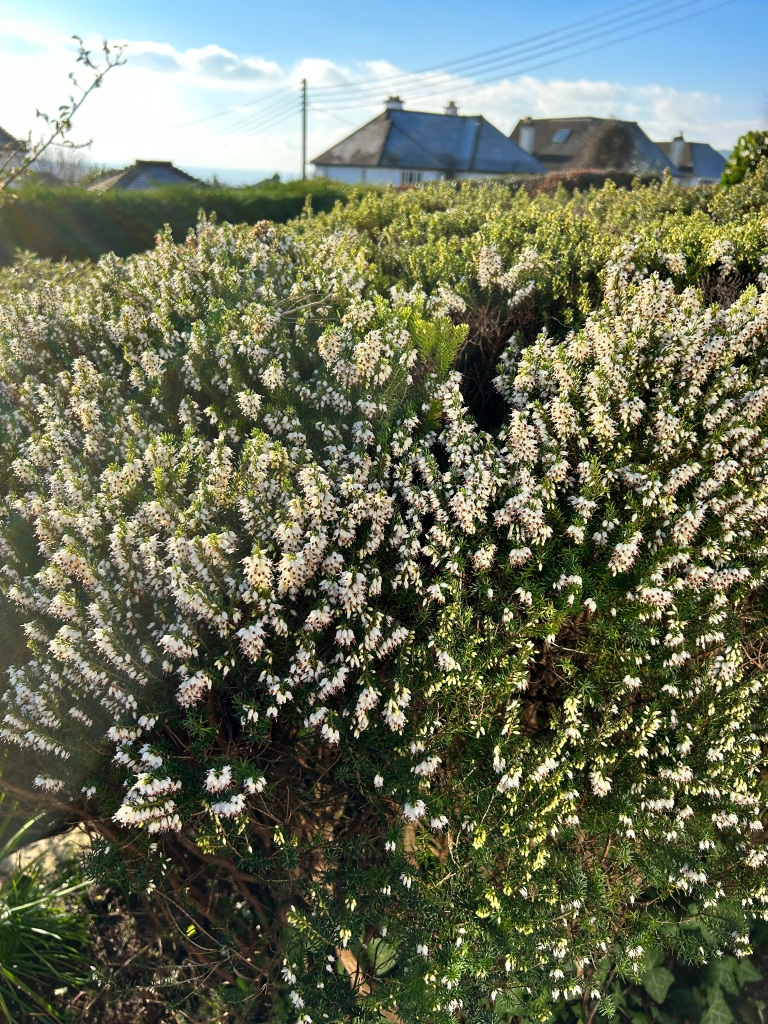
A bushy tree heather, this sits outside the sitting room window and used to be hidden behind a cotoneaster hedge. I’m not keen, but at this time of year it is a welcome bloom. I think later in the year it will get taken out as we continue to refresh this part of the garden.
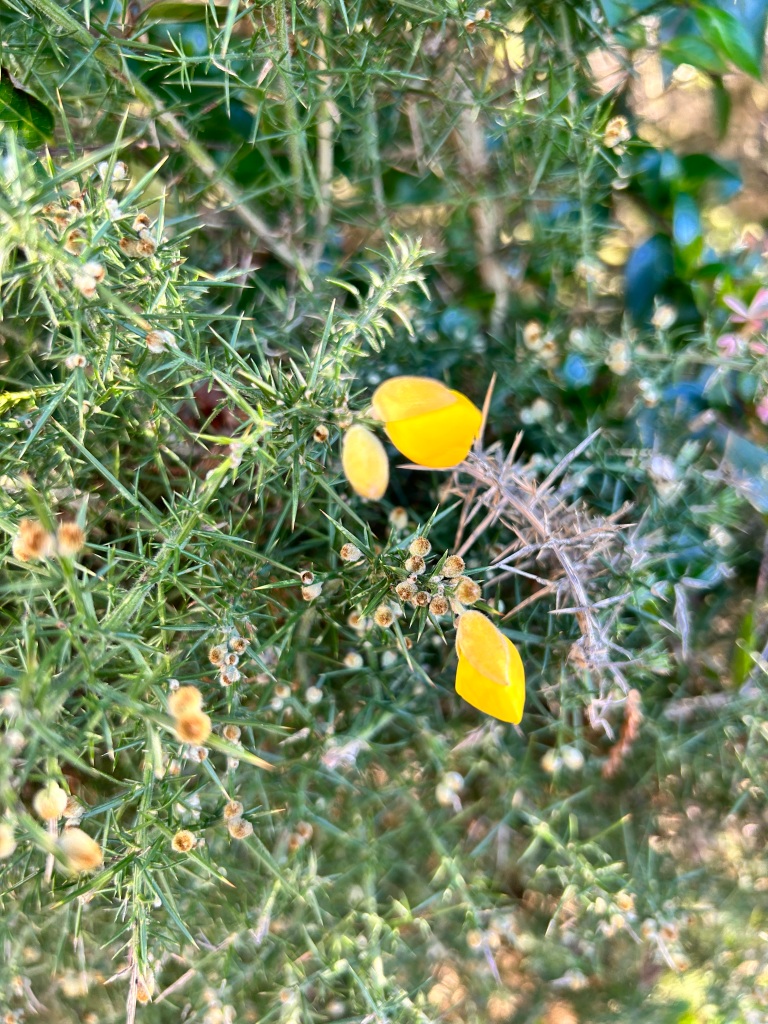
The gorse bush is beginning to flower. In a week or two it will be a mass of coconut smelling flowers and I will think it’s the most glorious thing we have in the garden. Briefly. Vicious spikes too, so we have to keep it pruned well away from the postman’s path.
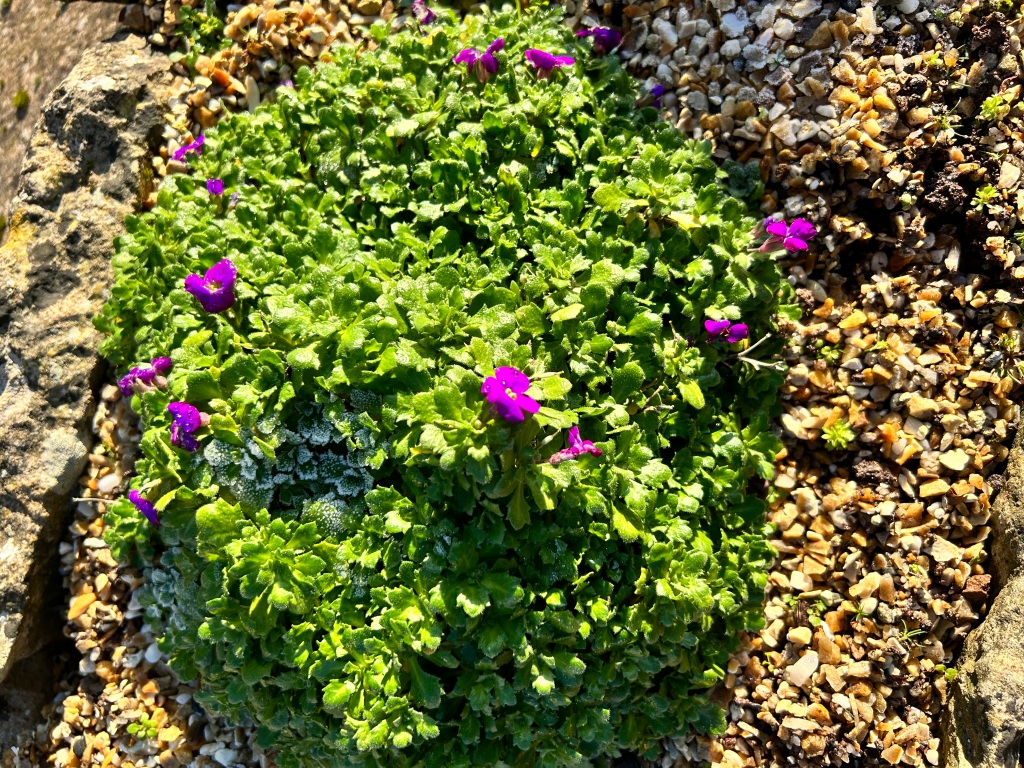
A tiny patch of aubretia is braving the cold. It started flowering just before Christmas and keeps popping out a few flowers at a time. It is outside the kitchen window in a long thin bed of rockery plants and alpines. You can see the frost on the plant, but it doesn’t seem to mind. And neither does this saxifrage.

Beautiful rosy pink flowers, this put out its cushion of blooms just before Christmas too. It’s next to the path to the driveway and is so cheery, turning up its starry faces to the cold, blue sky. It has frost still on it too, and I think will need separating into clumps later on as the middle will probably die off. Until then, it’s a promise of better weather to come.
Hope you are all well, and able to get into your gardens.
The week started with leaf raking. Hard, and because it’s so wet, heavy work. About half of them up I should say and most of them packed down for leaf mould in an old compost bin. At this time of year we ask ourselves why we have deciduous trees in the garden – a cherry and a red maple. They give lovely colour all seasons, but right now I could happily get rid.
The lawn is a quagmire, and as we raked we noticed that the wretched brambles -which are out of control – have layered themselves into it in a couple of places. After Christmas I think we will have to get someone in to clear this part of the garden completely. It has defeated us. There is not much there worth keeping, just a tree peony and a few nerine bulbs. The rest is laurel and sedge grass and brambles and to be honest, it will be good to have a blank canvas. The new fence is up now so we won’t have to think about plants to make a boundary.
Since I last posted, it has been a) too cold and b) too wet to do much in the garden so I have very few pictures of the garden worth sharing with you, but here is an attempt to find something.

The aforementioned new fence, looking pristine and rather bright. It will soon silver down. And hopefully stop our ‘friendly’ neighbours across the lane from complaining that our overhanging shrubs damage their car.


Here are two ladybirds braving the weather. A rather nattily dressed yellow, and a more conservative red. I hope they weren’t out of hibernation for too long, or that they didn’t get eaten by some passing bird. Note how I have artfully captured them on different backgrounds.

Here is a perfectly beautiful mature tree in the sunshine between showers at our local botanic gardens at Bicton. There are some amazing trees there, big planes, splendid sweet chestnut and oaks as well as more exotic specimens. I loved the way the light was on this.

This is a camellia, not sure which variety because it’s actually in a neighbour’s garden. It had about four days of these flowers before the cold snap turned them into soggy brown clots.
And here, in all its minimalist glory is our Christmas tree for this year. We love it. Take it out of the box, plug it in, and hey presto, it’s done. I hope you and yours have a safe and happy Christmas and a quiet and peaceful new year. Here’s to a great year’s gardening to come!
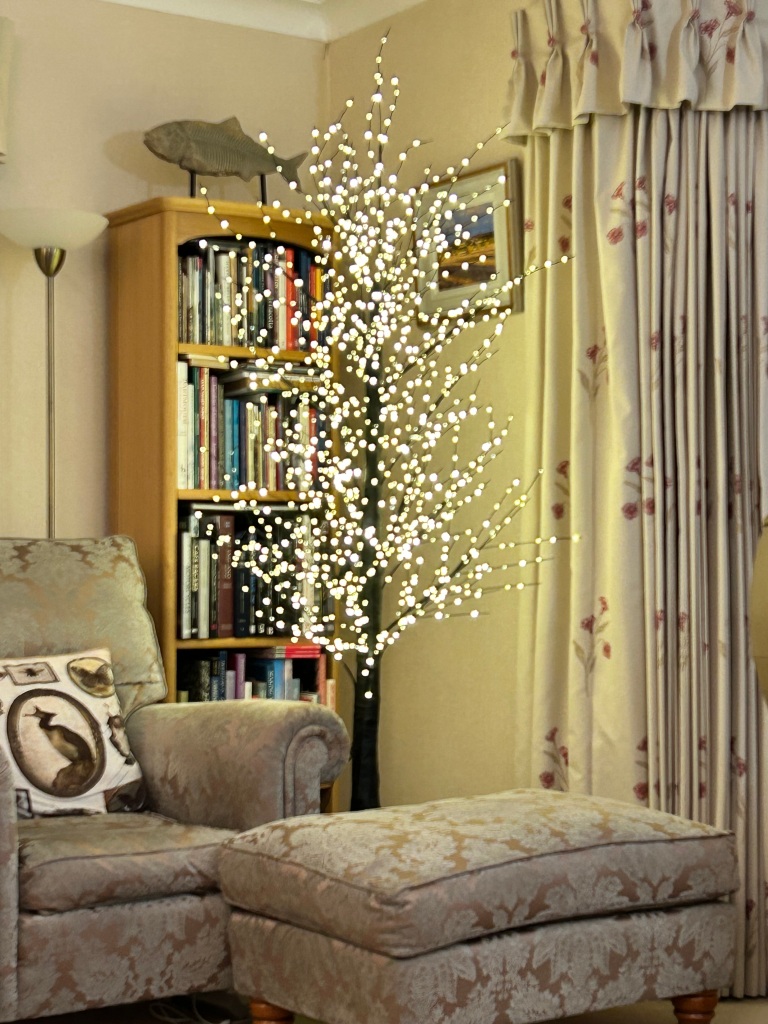
Aprés le deluge……daft warm weather again. So much rain fell here on Tuesday and Wednesday that I had to put three buckets into the leaky lobby. It sluiced it down, rapidly followed by rising temperatures again. 17 degrees in November is crazy and the plants are behaving in an equally crazy way. (Fortunately I noticed that this originally said ‘the pants are behaving in an equally crazy way’).
This is a geum, flowering in a way that suggests it’s thumbing its nose at the season. I think it’s Scarlet Tempest, but can’t be definite about it. They are pretty robust and do have a long flowering season, but end of November? Happy to see it, though.

And what’s this? A rogue tomato seed that has germinated and is growing quite happily outside in the border. Tomato seed germinating and growing OUTSIDE at the end of November. The world is upside down. It’s enough to make your pants behave in a crazy way.

More seasonal are these strange seedheads. The plump capsules have split to reveal pearly-white, shiny seeds. A sort of cross between a fat sweetcorn and a plump pomegranate seed. They’re the seeds of Naked Lady Lily amaryllis belladonna. I’m pretty sure I’ve posted this before, but beggars can’t be choosers and anyway, I like them.
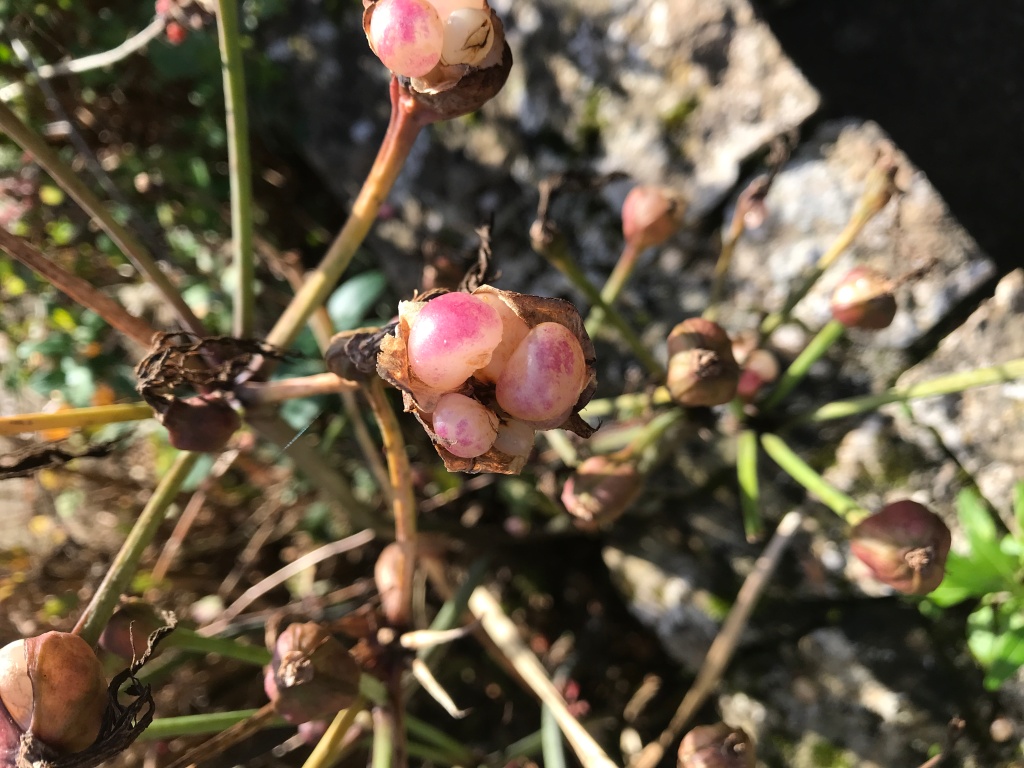
More unseasonality up next. This argyranthemum was a forlorn specimen on the poorly shelf at the garden centre. Grown on a little stem, it was past its best but did OK in late spring and then got planted in the garden. As you can see it has rejuvenated itself splendidly. Big, beautiful foliage and a flush of flowers coming. In November. More crazy pants.

Anyone for anemone? These seed themselves around from one small clump planted three years ago. This one is nicely filling a hole left by the broken corner of a paving slab and I am delighted by its initiative. Now these do flower in the late winter/early spring, but all the same this is either very late or very early. I love the fresh green of its frondy, ferny foliage and its jewel coloured flowers.

And last but not least, the one dry day that was Friday meant we could get some of the bulbs planted. Just less than half, I would say. The containers have the tulips. A bit boring right now but in a few months they will be a riot of Beautiful Blues, Flaming Parrot, Estella Rijnveld (my favourite), Blue Beauty, and Angelique. Can’t wait. You might remember that this is where the cotoneaster hedge used to be, in front of those sickly looking conifers. We grubbed it out a few weeks ago and plan to renew this bit of the garden over the coming spring. Getting the hedge out meant we also destroyed a pretty little rough stone wall, but we have the stones and can piece it back together. On the far right of this pic is an agave which is doing very well in its pot. I don’t know the variety but this year it has probably doubled in size. I hope to plant it in the garden when it gets a bit bigger. In the gap between those two houses you should be able to see the sea – just not today.

That’s it for today. Hoping for drier weather soon or we will be re-designing the garden as a swamp. I’ve always fancied a gunnera…..
If you’re not already part of 6-on-Saturday from the garden then join in with Jim. Leave your link in the comments section of his blog.
Rain. Lots of it. As a consequence, not much gardening done, other than weeding. Fortunately, wet ground assists with weeding. Unfortunately the old body does little to accommodate it. Knees no longer allow kneeling or squatting (can’t get up unaided plus painful), so weeding has to be done rather inelegantly by a bend from the waist. Sadly, the bobbing up and down upsets the old vertigo and after about an hour I start feeling sick, so weeding has to be meticulously planned. Heigh ho, the ageing body!
Last time, or maybe the time before, I posted a picture of our new Brugmansia. I thought it would have been settling down for winter by now, but no, it is covered in flowers and plenty of buds to come. I am delighted with it. It is Brugmansia sanguinea ‘Aurantia’ and we picked it up in the spring at our favourite nursery, Plant World near Newton Abbot.

From the same source is this Beschorneria yuccoides, also doing very well in our milder climate. It is in a directly south facing bed and has tripled in size in two years. I wasn’t sure it would overwinter outside, but it seems to be ok so far. It’s a native of Mexico, I think, and should be good down to about -5.

And another of our hopeful exotics is a Fascicularia bicolour. This is a bromeliad; a Chilean native and again good down to -5. It’s been in a very sheltered spot for two years to get it established. I plan to move it to the top of a low south-facing wall which will help with drainage. It has fiercely serrated edges to the foliage though, so careful handling is a must. If it’s happy it should develop a crimson red base to its foliage in late summer and produce a sort of proteus-like blue flower. If it works it will be weird, and wonderful.
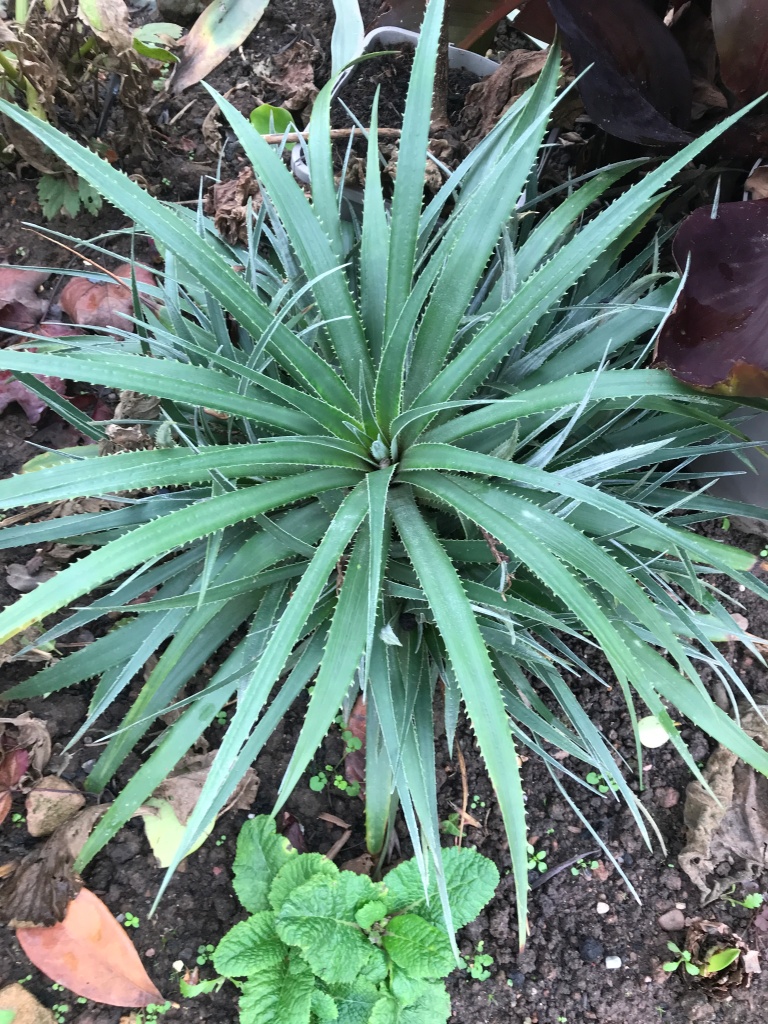
Still flowering are some very cheerful Gazania. They have been good value, opening their bright, stripey faces to the sun since June. Regular deadheading has helped their longevity. I hope they keep going a little longer.

The nerines are out and providing the usual blowsy pink show. Very useful at this time of the year, these plants are pretty old and are pushing themselves further and further out of the ground. I can’t decide whether to leave well alone, or to split and redistribute. I do know that they can be temperamental, so if anyone has nerine expertise I’d be grateful for advice. I also have a huge old crinum which is doing the same. To split, or not to split, that is the question. And while we are in that family of plants, the amaryllis belladonna, or Naked Ladies, have finished flowering and have formed fat seedheads full of white seeds, a bit like pomegranate seeds. Does anyone know if I can grow them on?



All these plants are in the same part of the garden – the borders at the front and side of the house, south and south-west facing. A bit exposed in winter, but one of the few parts of the garden that is reasonably well drained as it’s on a bit of a slope. We also grow the canna and dahlias here, now over.
Well that’s it for October. If you’re not already part of 6-on-Saturday from the garden then join in with Jim. Leave your link in the comments section of his blog.
It’s taken all week for me to stop humming Beethoven’s Funeral March, but this morning I found myself singing Joni Mitchell’s For Free, so I am hopeful that I am out the other side of the last sombre two weeks.
The weather is cooler suddenly and so the autumn garden works are starting. The messy garden across the front of the house is our point of departure. To the left of the gate is a small patch with a hydrangea, crinum, a totally out of control senecio, all encroached upon by ivy which has embedded itself in the senecio roots. We have managed to cut down the senecio but getting out the old root stump is going to be more of a problem. The plan is to take out everything and start again. When I started to cut the crinum back, I found beautiful bright orange seed in bursting pods. They are Iris foetidissima and I had no idea they were there. I shall attempt to propagate from the seed but I think it can be difficult. Still, nothing ventured… Taking everything down to soil level has also exposed the top of the wall, which was completely covered with ivy. It has brushed up nicely.
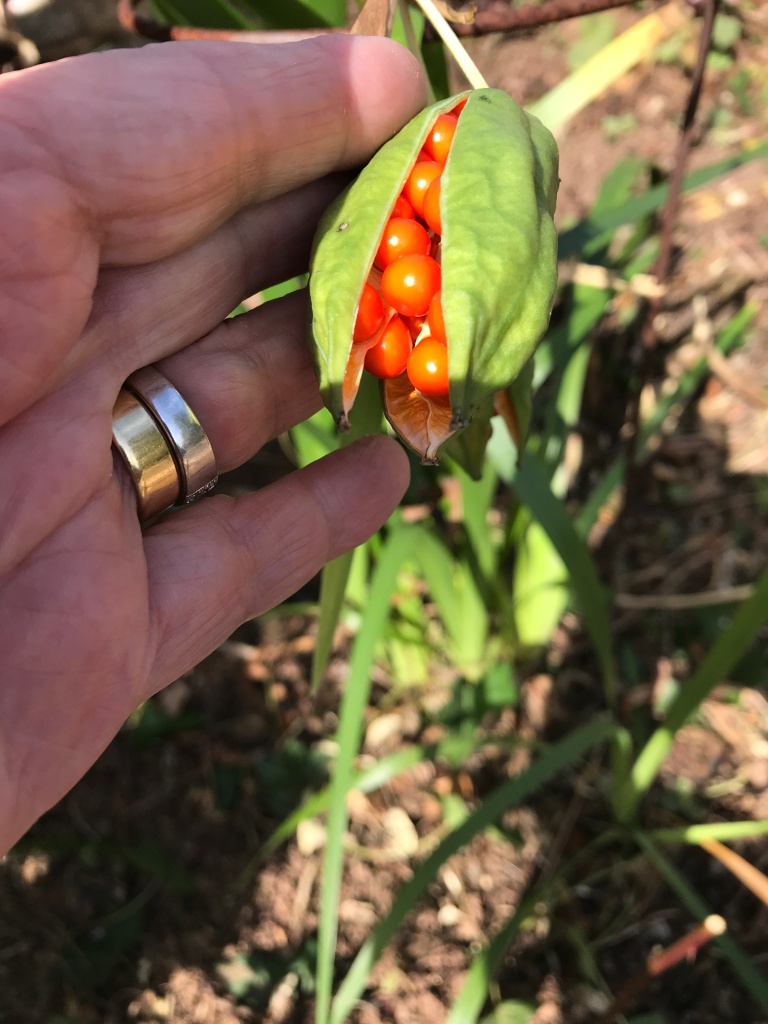

This week we have someone coming to cut back all the shrubs to the left of the gate where the garden runs along the lane. The plan there is to put up a fence, but at the moment we’re not sure if it will be possible without actually removing some of the larger shrubs. We haven’t done anything to this part of the garden since we moved in 3 years ago, so it’s time we got to it.
More doom and gloom as we examine the huge viburnum tinus – it has succumbed to viburnum beetle and quite a lot of it is now a moth-eaten brown. Taking this down will be a job for the tree surgeons, so it will have to stay where it is and look bedraggled for now. Hopefully, once the chaps have been to cut back, things will look a little tidier, if bald. The hot, dry summer was a boon to pests and diseases; fuchsia gall mite, red spider mite, viburnum beetle, downy mildew, scorched foliage, it’s all been much worse than usual.
A large box of spring bulbs has been menacing us from the shed for a couple of weeks. They really need to go in, but the ground is so hard from the dry summer that there is little chance of that until we have had some substantial amounts of rain. Fortunately some late summer bulbs/corms are doing well – these Naked Ladies (Amaryllis belladonna) are a real show. I wish we had more.

And these aeonium are still enjoying the last of the sunshine. We have moved them to just outside the front door, so their upturned faces greet us every time we go out and come back. They’ll soon go into the cold greenhouse to overwinter with the geraniums. Rudbeckia is also holding onto the sunshine for us and reflecting it back in its brown-centred daisy flowers. Such good value, I plant to split this once the flowers have gone over.


I hope that this counts as a 6, but if it doesn’t I ‘m still including it. It’s a biography of Ellen Willmott, the Edwardian/Victorian gardener and plantswoman. Responsible for many varieties of daffodil and of course the eryngeum giganteum that bears her spectral name. Not much is known about her life. She was famously eccentric in later years but this book pieces together her earlier years from fragments of papers found in a disintegrating archive at Spetchley Park where her sister lived. It’s a fascinating book and I recommend it to you.

This sweet chestnut (Castanea sativa) isn’t exactly in the garden, more in a garden we regularly visit, but it looks so ‘of the season’ now with its bright green spiny seed cases promising creamy chestnuts to roast. Personally, I prefer the luxurious soft and candied marrons glacée, an infrequent, and expensive treat.

So those are my infrequent offerings for this week. If you want to get a glimpse of lovely gardens from across the world, and chat to lots of lovely gardeners, then go here https://thepropagatorblog.wordpress.com/2017/09/18/six-on-saturday-a-participant-guide/ and join in!!
Where to start? In spite of a little rain this week, the garden is like a desert. Hard cracked ground, lawn frazzled and crisp, some perennials lost – penstemon, gaura, delphinium – and a hydrangea, all lost to the extreme heat of mid-August. Four days of temperatures above 26 degrees finished them off. We concentrated our watering on the vegetable patch, even so, some things bolted in the heat – lettuce and chard specifically, but other things are doing well. The squash is rampaging and we have three good fruits off the Crown Prince and a couple of decent sized butternut. I’m pleased because we have never grown them before. All the beetroot are out of the ground now and will be pickled. The runner beans are still producing well, courgettes almost over, and a lovely crop of Charlotte spuds from the six seed potatoes I planted. Tomatoes have been fair. We’ve had a reasonable amount but the plants haven’t done as well as I’d hoped in spite of feeding. The only difference in their cultivation was the use of a peat free compost. Hmm. Same with peppers and cucumbers – disappointing. Those making peat-free compost need to up their game.

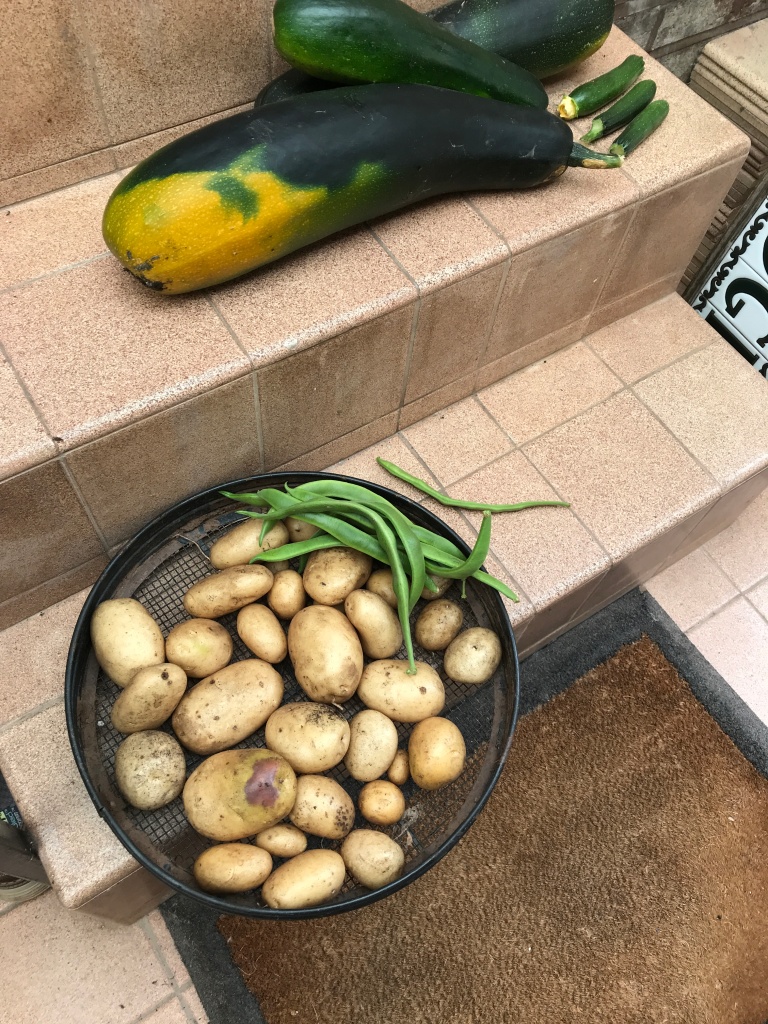
In order to increase our supply of home-made compost we have invested in this neat tumbler which will hold 240 litres. We are filling it as the veg beds get cleared and hoping for useable stuff in three months or so. I’ll let you know if it was worth the money!

Flower-wise, the agapanthus have been amazing, lots of flowers, and the canna have just adored the sunshine. Dahlias are also doing well now. My absolute favourite flower this summer has been a stunning gloriosa. I’ve never grown them before and didn’t quite know what to expect but it is just magnificent.
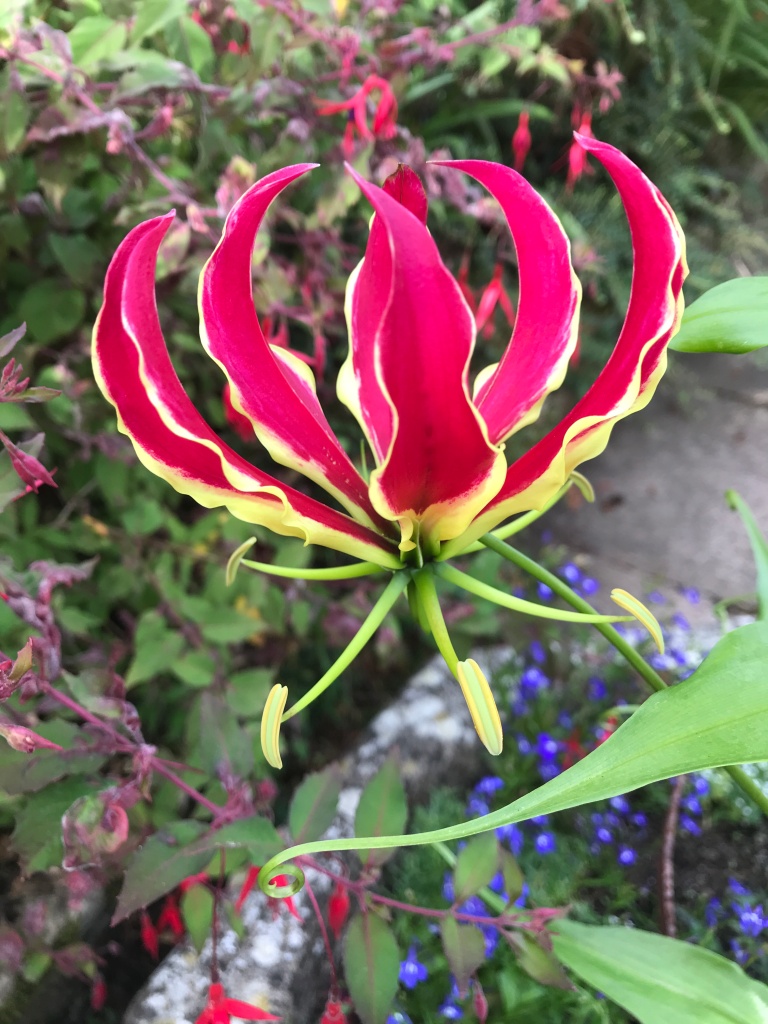
Above is gloriosa Rothschildeana. These fabulous flowers lose the edge of yellow as they fade and the petals slowly lose the reflex. I shall be growing more. We have them right outside the sitting room window so we can marvel at them every day.
We have also been delighted by a brugmansia. Bought as a quite small plant from a fairly local nursery we didn’t have high hopes of it for this year, thinking it would take this season to establish itself. In a large pot it has put on at least 2 feet of growth and rewarded us with six blooms so far. We’ll probably over winter it indoors this year, but I have a plan to grow it in a border, well protected by other shrubs.

The hot sun also bought a blessing of butterflies – Red Admiral, Painted Lady, Comma, Peacock and small Tortoiseshell, Holly Blue, and Gatekeeper were the ones we noted most often (plus small and large White, of course). Also a few visits from Hummingbird Hawk Moth, which is always a treat. This picture is from Butterfly Conservation. They’re not a large hawkmoth, but their tawny wings and chequerboard body make them unmistakeable, plus the fact that they hover just like the eponymous hummingbird.

Our fuchsia bushes are ruined by gall mite again this year. I think in the autumn we will take them out if we can and start again with something else. If anyone reading this is aware of a fuchsia variety that doesn’t succumb to the dreaded gall mite, please let me know. I love the dainty fuchsia flowers, large or small and whatever colour combination, and it breaks my heart to see them shrivelled and damaged.
Anyhow, enjoy what’s left of the summer and I hope you have enough rain, but not too much. This is my occasional contribution to Six on Saturday. For more of them go to the site of the chap who started it at https://thepropagatorblog.wordpress.com.
I started writing this on the 7th July but then things intervened and I am ashamed to find that it’s over a month since I last posted. So many things to keep on top of, I’m not sure why it’s the blog that gets sidelined. Look at what I drafted last time: “Some lovely weather since my last blog and also some very wet weather. This last week it has rained pretty much every day – heavy showers and then sunshine. The garden is absolutely loving it. The courgettes are taking over the veg plot and we have already started that summer thing of ‘how creative can we be with cooking courgettes?’. Well, what a difference ten days makes, eh? We’ve already emptied the water butt.
I like the warm, but I can’t handle the heat. Anything above about 23 degrees has me sighing and reaching for cover. So this weekend and early next week will be interesting. The garden is already dry as dust, but fortunately, some flowers are still shining forth. Us humans are using all the tips and tricks – windows open only until 10.30, blinds and curtains drawn all day. Chilled drinks to hand in the fridge, a freezer full of ice lollies. Minimal clothing, all loose and thin, and..sssh…no underwear. Too much information?? Sorry.
Anyway, the garden is still full of young birds. This week we’ve had regular visits from a large family of long-tailed tits. The youngsters even smaller than the adults and very cute hanging upside down in our fir tree. We also seem to have been adopted by some young magpies, they’re not so cute. Cackling and squabbling early in the morning and at dusk, they think they have taken up residence at the top of the pittosporum (yes, our pittosporum is a tree some twenty feet tall). Mr OG has other ideas and has taken to stalking them with a long stick. The front garden is looking good, the back garden is totally overgrown. It will probably be autumn now before we begin to tackle it. The front garden needs diligent weeding still, but they are becoming less and less now. Concerted effort and a timely pounce at first sight works wonders. Any way, here are six things from the garden, more than six I think. It’s such a long time since I last posted, I thought I’d better make up for it:
Here is a small canna; and a tall canna. We have a whole bed full of them. Mr OG loves them and will keep buying more. We overwintered these in the garden from last year and are very pleased with them.


These are the first of the dahlias. I never used to like dahlias, now I love their jazzy colours and odd shapes. I am particularly fond of the single flower ones, this one is lovely. We have them around the outside of the canna.


In the summer you can’t beat a daisy – lifting their faces to the sun and just beaming away in the bright light. Here is what I call a Michaelmas daisy and some of those shaggy purple daisies that grow like weeds at the seaside; it’s erigeron glauca, aptly named Sea Breeze. That’s hardy geranium ‘Rozanne’ trying to smother it.

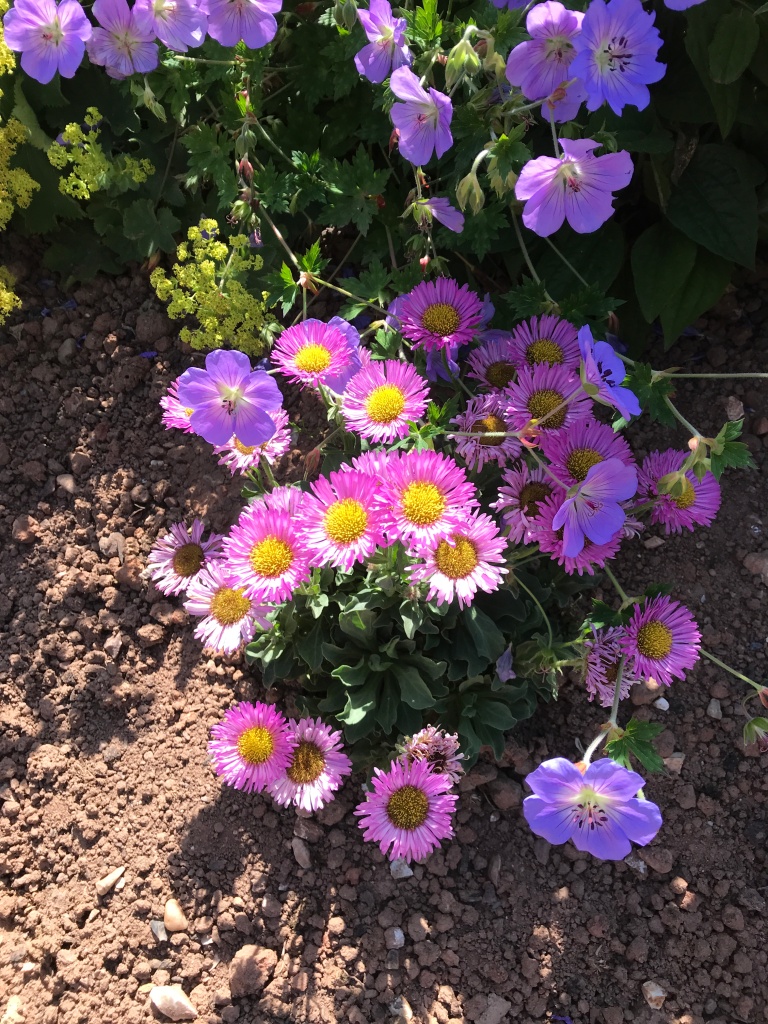
And here is gypsophila, the lower growing sort. Isn’t it beautiful? And flowering now for three weeks or more. Next year I plan to fill the garden with it. And in complete contrast is this emerging crinum (predictive text keeps trying to change this to cranium, but I’m having none of it). It will soon be a head (ha!) of bright pink trumpets on a thick stem, a bit like a massive, less spidery nerine, or a multi-flowered amaryllis. Not surprising really, as they are all from the same family.

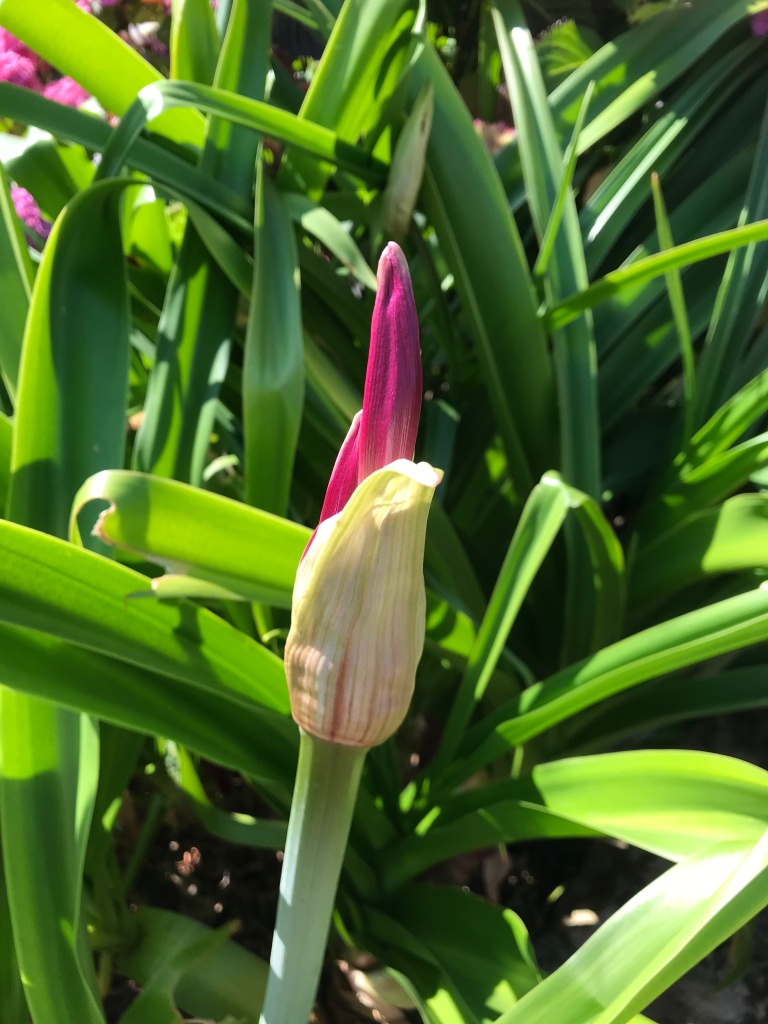
And bringing up the rear is this rather splendid ensete ventricosum ‘Maurellii’. Bought in a fit of optimism from a garden show back in May, it is thriving in this heat and has been repotted once. We will bring it indoors overwinter and hope to keep it going. It’s not a great picture, but you get the gist of it.

And that’s it. Time to put the washing out and then see how it is for doing anything outdoors. At the moment it’s 24 degrees and with a bit of luck won’t get much higher today. Even so, I think ‘doing’ will be restricted to sitting in the shade with a book, and maybe my knitting. Keep cool, keep safe. 😎
A week of beautiful sunny weather and good temperatures. We’ve been out and about visiting gardens for inspiration and relaxation. On Monday was National Trust Knightshayes Court where we always head straight for the huge walled kitchen garden. The gardeners and volunteers do a terrific job managing such a big space and we are invariably impressed. There are useful little boards dotted in the beds with information about what’s growing and what’s problematic and how they are dealing with it. The veg was looking good – especially the broad beans and brassica, and a huge bed of rhubarb with a note saying that they pick it until midsummers day and then leave it alone until the following year. In the middle of the garden is a round pond with raised sides – it was probably designed as the dipping pond for the garden, but it has been planted up and the water level is very low. Nonetheless, a female mallard was busy encouraging her six ducklings to climb out and disport themselves in all their fluffy, stripey cuteness on the grass paths. On the other side of the house (Victorian gothic) the herbaceous borders were full of peonies and iris, and hardy geraniums, with great billowing clouds of gypsophila drawing the eye. Lovely.


Later in the week we visited another favourite of ours, the much less well-known Burrow Farm Gardens hidden in the Devon countryside between Honiton and Axminster. This is a garden that fits perfectly into the landscape. There are beautifully planted gardens; we were very taken with roses climbing through trees – a scarlet rose through an acer was particularly striking – a garden of grasses dotted with perennials; a long slope with shrubs leading down to a pool alive with dragonflies and damselflies like jewels over the water; a quarry garden and a glorious wildflower meadow noisy with bees and studded with orchids. There’s also a collection of cornus trees that are magnificent at this time of year. It’s an absolute delight. Do seek it out.







At home we are still working hard in the garden – weeding mostly, but also finding space to plant one or two unusual things that we have picked up from our favourite local(ish) nursery – Plant World.

This is digitalis ferruginea or the rusty foxglove. The bees absolutely love it and the small browny-pink flowers with a creamy yellow interior are really sweet.

And this is silybum (yes, really) marianum or St Mary’s Milk Thistle. Common enough but usually rooted out of gardens. That variegated foliage is stunning and I can’t wait to see the purple flower.
There’s more but I don’t have decent photographs yet. More good weather is promised next week so I’m sure we will be out and about and I’ll have more to share.
This morning I realised I haven’t blogged for almost a month. My love for knitting rather took over my life as I finished two pairs of socks and a slouchy cardigan for chilly summer evenings. I’m one of those personalities that can’t put something down mid-way; I have to keep going til it’s finished. I’m the same with books, and sweeties.



The weather has been variable. Periods of good strong sunshine, almost always accompanied by a cool breeze though, and hardly any rain for the past couple of weeks. The garden is growing strongly and work is being done as and when it can be fitted in. We are turning our attention to the large side garden which is very overgrown and I am struggling to convince myself I can get away with insisting it is ‘re-wilding’. The brambles are beyond a joke and yesterday I noticed two cherry saplings and an ash. I suspect it’s going to be a mixture of digging and fairly noxious weedkiller, carefully applied. In the meantime, we are tackling small patches at a time. This week we cleared the half-moon bed which had been planted with roses. The roses have never settled properly and were weak and spindly – the soil is poor and it’s the drier part of the garden. In spite of soil improver and mulching, they haven’t taken to it at all. Two of the roses we transplanted into large pots – Gertrude Jekyll and one of the Munstead Wood are now thriving in their own little micro-gardens. The other two Munsteads look too feeble to rejuvenate, but I have pruned them right back and we will persevere in pots for a while.


The garden is full of young birds – goldfinches with the bright wing bar but no red faces, chaffinch, tubby little blackbirds with short tails and rich, chestnut speckled feathers. Mama blackbird helped us in the garden, around our feet darting in for anything that moved – mostly wireworms. We have had the robin close to us in the garden before, but never the blackbirds. She wasn’t a bit afraid and was backwards and forwards all afternoon. Blue tits were diligently working their way through a fuchsia bush, winkling out the froghopper babies from the cuckoo spit. The fuchsia bush is a real trier – we have fuchsia gall mite and all our fuchsia bushes have succumbed. I’ve removed some, but left a couple of bushes at the front and cut them right down to the ground in early spring. They have flowers, but all the tips of the new shoots are discoloured and distorted. I’m trying to weigh up whether the flowers are worth the unsightly foliage. It’s a close run thing at the moment so no pictures.
The cottage garden is beginning to fill out now, although there is still plenty of space for planting. It’s very hot there, in full sun all day so I have dotted in osteospermum and some rather splendid gazanias which are both very cheery and love the sun. The lychnis is flowering – a fabulous lipstick deep cerise against grey foliage; and an argyranthemum has been flowering for weeks. Last year’s canna came through the winter really well and are growing up nicely, there are flower spikes on the shorter ones, and likewise the dahlias – winter survivors and putting on good growth.

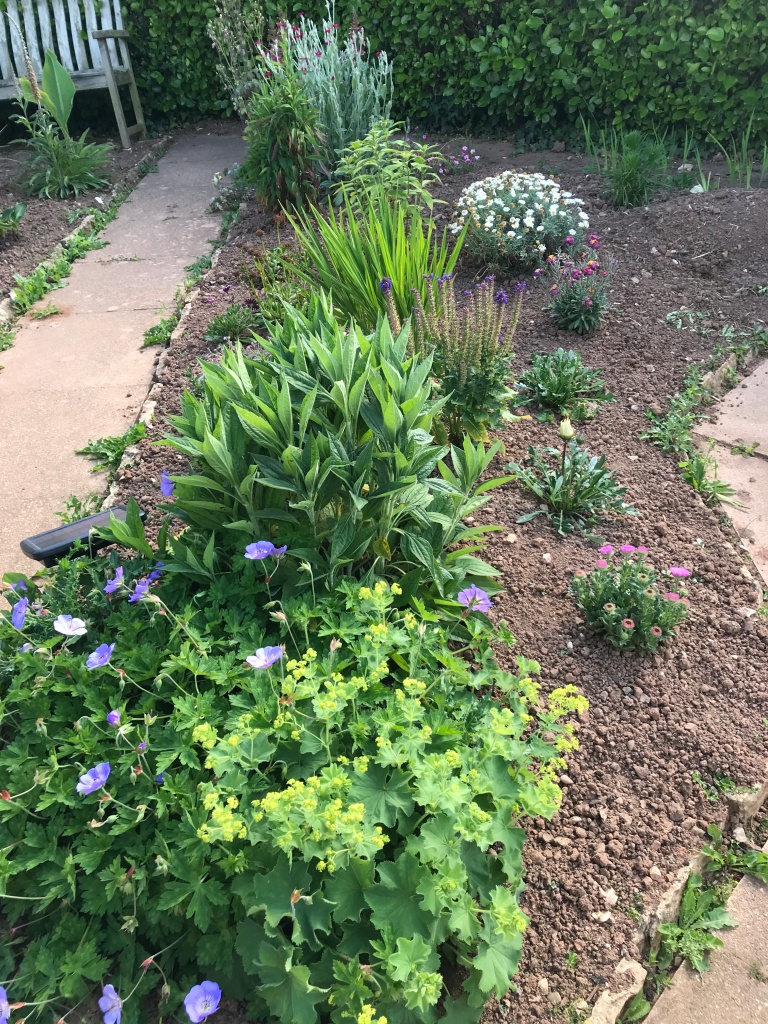
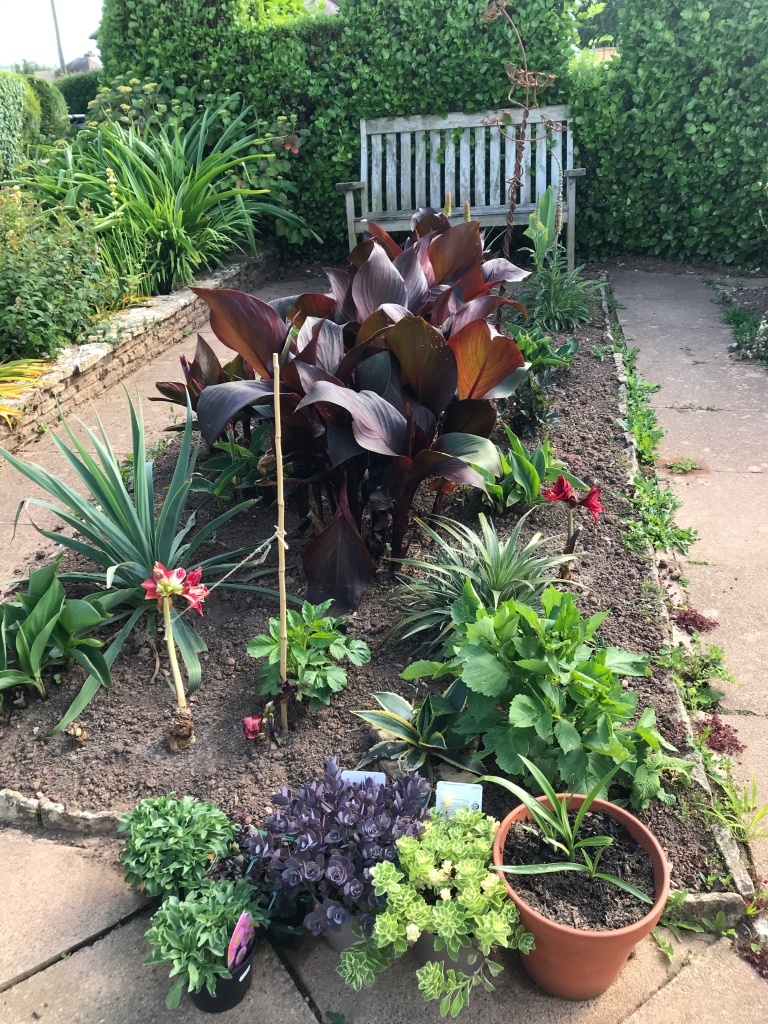
Today we sat on the deck and watched the small fields on the hill being cut for hay. The tractors and machinery like Dinky toys being moved by some invisible hand across the faded fields. First a tractor pulling the baler moving diligently around the field in ever-decreasing circles, occasionally slowing to release a bale like some strange grassy egg. Then a small tractor with forks trundles in and picks up two bales at a time, taking them across to the field gate nearest the road and lining them up in a row of stumpy , rotund soldiers. They’re small fields and small tractors and it’s almost like going back in time watching them work. There’s something comforting about watching the fields fulfil their purpose across the seasons, and trying to feel that age-old connection with the land.

oOo